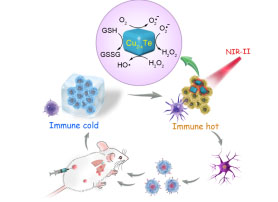Recently, the team of Professor Liu Younian from the School of Chemistry and Chemical Engineering of Central South University (CSU) has made a series of progress in the field of anti-tumor immunotherapy. The findings have been published in the world's top academic journal Angew. Chem. Int. Ed, with Dr. Wen Mei as the first author, Associate Professor Chen Wansong and Professor Liu Younian as the corresponding authors.
Malignant tumors (cancers) are one of the major diseases that pose a serious threat to human health. Traditional anticancer treatments include surgery, chemotherapy, and radiotherapy. However, tumors are prone to recurrence and metastasis, severely limiting the efficiency of anticancer treatments. In recent years, the anti-tumor immunotherapy based on the human body's own immune system has provided new ideas for inhibiting tumor recurrence and metastasis. Unfortunately, the effect of immunotherapy alone is poor. The main reason is that the tumor is in an immunosuppressive state, and there is an immune escape mechanism, which inhibits the generation of anti-tumor immunity in vivo. Based on this fact, Professor Liu Younian’s team proposed to carry out anti-tumor immunotherapy using the catalytic cascade of synthesized enzymes. The researchers first designed and prepared Cu2-xTe nanoparticles with near-infrared II (NIR-II) absorption. The study found that both the glutathione oxidase (GSHOx)-like and peroxidase (POD)-like activities of Cu2-xTe nanoparticles could be further enhanced under NIR-II illumination. Through the double-enzyme catalytic cascade reaction of Cu2-xTe nanoparticles, the oxidation of glutathione in tumor cells is effectively promoted, and hydroxyl radicals are generated to increase the intratumor oxidative stress. The cell and animal experiments showed that synthesized enzyme Cu2-xTe promoted apoptosis of tumor cells and release of tumor-associated antigen, and reactivated the immune system through oxidative stress to produce anti-tumor immunity. This treatment strategy not only effectively eliminates primary tumors, but also effectively inhibits the growth of distant metastases and reduces tumor recurrence. In short, the study develops a new NIR-II light-controlled synthesized enzyme and has been the first to apply a synthesized enzyme in anti-tumor immunotherapy, opening up a new direction of catalytic immunotherapy.

Figure 1. Schematic diagram of applying synthesized alcohol Cu2-xTe in tumor catalytic immunotherapy: Cu2-xTe consumes GSH in the tumor and produces hydroxyl radicals through the cascade reaction; therefore, it could destroy the primary tumor and activate anti-tumor immunity to inhibit tumor metastasis and recurrence.

Figure 2. Application of Cu2-xTe synthesized alcohol inin vivocatalytic immunotherapy of tumors: a-b) growth curves primary tumor and distant metastases, c) mouse survival curve, d-f) inhibition of tumor recurrence and lung metastasis, g) generation of memory T cells.
In addition, the team members (Dr. Ouyang Jiang, Professor Liu Younian), together with and Dr. Wei Tao from Harvard Medical School, have discovered a fast preparation of a new type of two-dimensional nanomaterial terpene by ultrasonic exfoliation method, which inhibits good photo-thermal properties and biocompatibility and can be used for photothermal therapy of tumors. Related results are published on Angew. Chem. Int. Ed., 2019, 58, 13405-13410. The related projects were funded and supported by the National Natural Science Foundation of China (21807117, 21636010), the Natural Science Foundation of Hunan Province (2018JJ3631) and the State Key Laboratory of Powder Metallurgy of Central South University.
Source: School of Chemistry and Chemical Engineering











